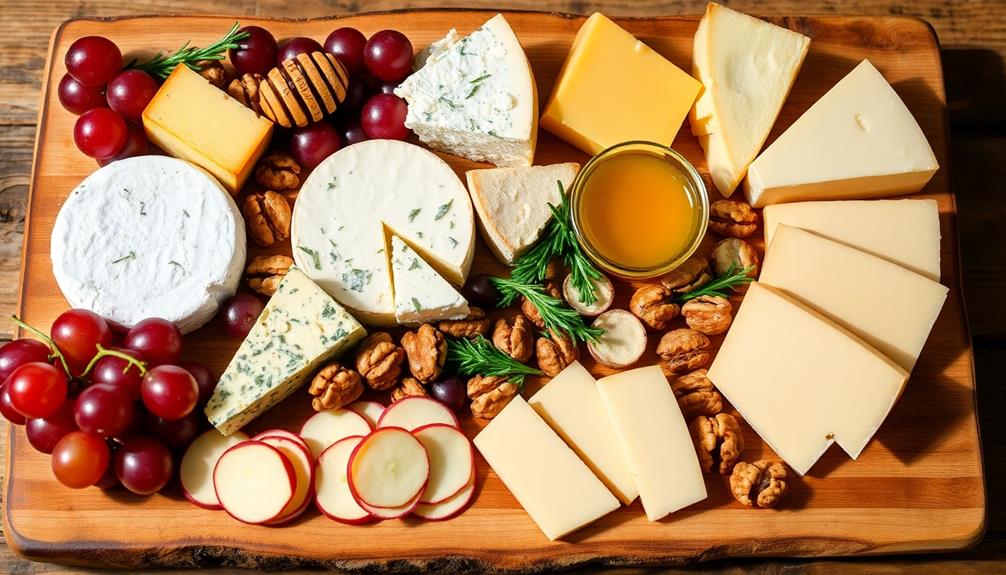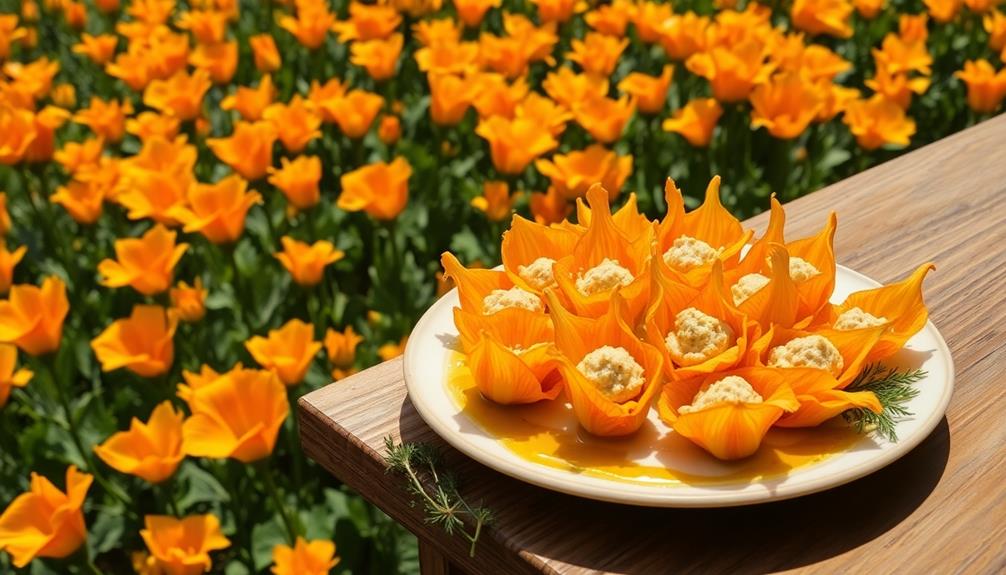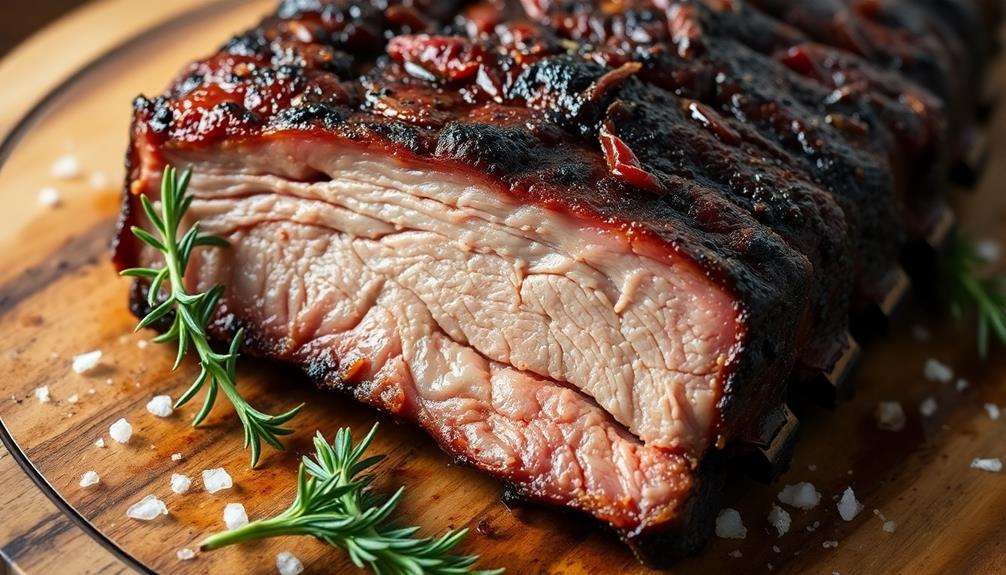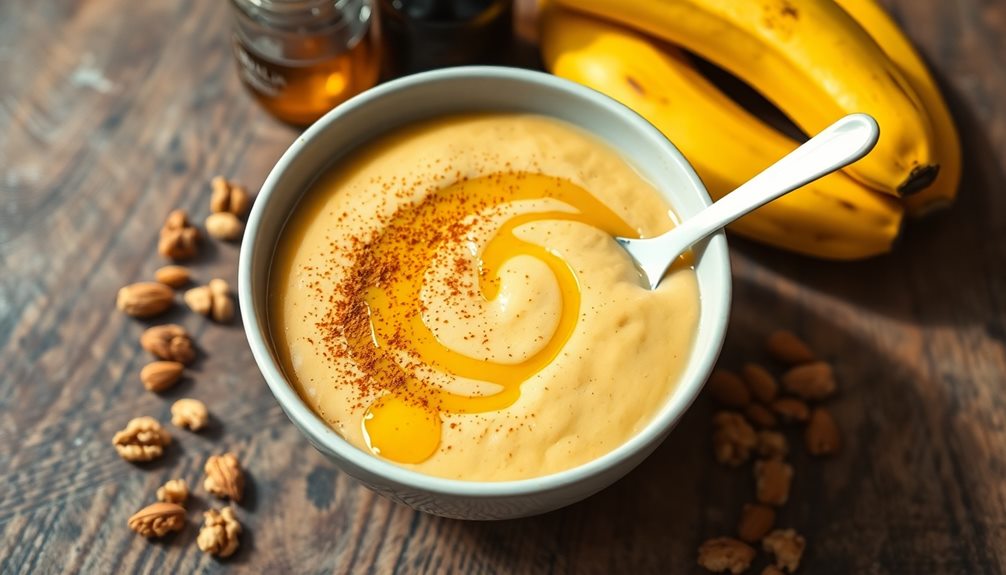Crafting an artisanal cheese plate is a delightful way to explore unique flavors and textures. You'll want to select 3-5 high-quality cheeses, including soft, semi-soft, hard, and blue varieties. Arrange them on a board with complementary accompaniments like fresh and dried fruits, nuts, and crusty bread. Don't forget to add honey or jam for sweetness, and olives for a savory touch. Serve the cheeses at room temperature for the best taste, and consider pairing them with wine or herbal tea. Remember, there's no strict rule – let your creativity shine as you assemble your plate. Dive deeper to discover more tips and tricks for creating the perfect cheese experience.
Key Takeaways
- Select 3-5 artisanal cheeses with varying textures and flavors, including soft, semi-soft, hard, and blue varieties.
- Include complementary accompaniments like fresh fruits, nuts, honey, and crusty bread or crackers.
- Arrange cheeses and accompaniments on a board for visual appeal, spacing items evenly for easy access.
- Serve cheeses at room temperature and provide appropriate utensils for cutting and spreading.
- Pair cheeses with suitable wines or beverages to enhance the tasting experience.
History
Cheese lovers have been assembling artisanal cheese plates for centuries. You might be surprised to learn that this tradition dates back to ancient times. In fact, the Romans were known to serve cheese platters at their feasts. They'd include various cheeses, fruits, and nuts on their plates.
As time went on, cheese plates became more popular across Europe. In France, you'll find that cheese boards are often served after the main course. It's a custom that's still practiced today. The French call it a "plateau de fromage," and it's an important part of their dining culture.
In recent years, you've probably noticed artisanal cheese plates becoming trendy in restaurants and homes. People are more interested in trying unique, handcrafted cheeses from small producers. You can now find cheese plates featuring cheeses from all over the world, paired with special accompaniments like honey, jams, and artisanal crackers.
Today, cheese plates aren't just for fancy events. You can easily make one at home for a casual get-together or a cozy night in. It's a fun way to explore different flavors and textures while enjoying good company.
Recipe
An artisanal cheese plate isn't so much a recipe as it's an art form, combining various flavors, textures, and visual elements to create a delightful culinary experience. The key to a successful cheese plate lies in the careful selection and pairing of cheeses, accompaniments, and presentation.
When assembling an artisanal cheese plate, aim for a diverse selection of cheeses that offer a range of flavors, from mild to strong, and textures, from soft to hard. Consider including cheeses made from different types of milk (cow, goat, sheep) and from various regions to provide a well-rounded tasting experience.
- 3-5 artisanal cheeses (e.g., aged cheddar, brie, blue cheese, goat cheese)
- Assorted crackers or crusty bread
- Fresh fruits (grapes, figs, apples, pears)
- Dried fruits (apricots, cranberries)
- Nuts (almonds, walnuts, pecans)
- Honey or fruit preserves
- Cured meats (optional)
- Fresh herbs for garnish
To assemble the cheese plate, start by arranging the cheeses on a wooden board or slate platter, spacing them evenly. Place the accompaniments around the cheeses, grouping similar items together for visual appeal. Add small bowls for honey or preserves, and include cheese knives or spreaders for each cheese. Garnish with fresh herbs to add a pop of color and freshness to the presentation.
For the best tasting experience, remove the cheeses from the refrigerator about 30 minutes before serving to allow them to come to room temperature. This enhances their flavors and textures.
When selecting cheeses, aim for a variety of milk types, ages, and styles to create a well-balanced plate. Don't forget to provide small cards with cheese names and descriptions to guide your guests through the tasting experience.
Cooking Steps
To create your artisanal cheese plate, you'll need to follow a few simple steps.
First, choose a variety of cheese types, like soft, hard, and blue, to offer different flavors and textures.
Then, arrange your cheeses on a board or plate, adding accompaniments like nuts, honey, and olives, along with fresh fruit slices and crusty bread.
Step 1. Select Various Cheese Types
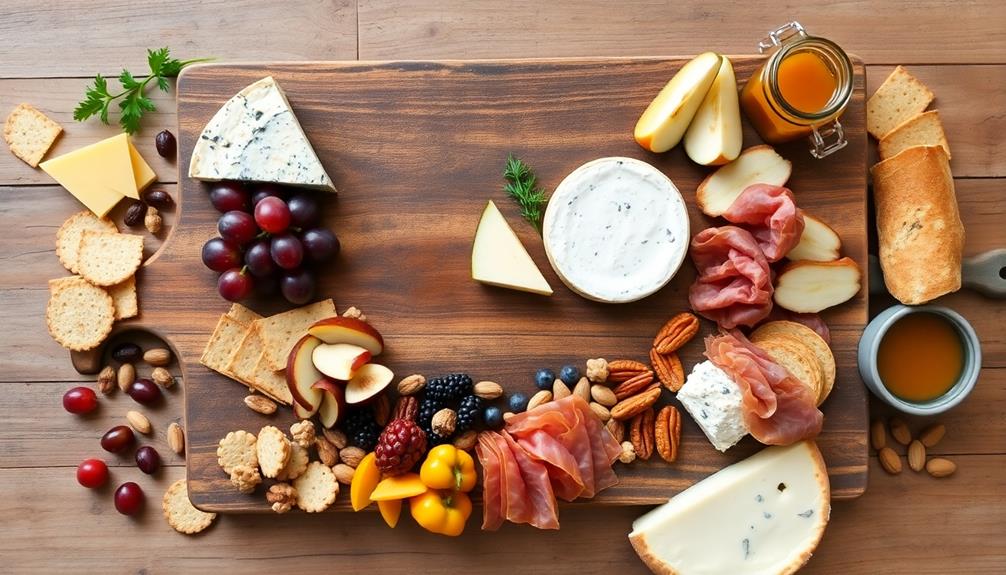
When assembling an artisanal cheese plate, selecting a variety of cheese types is crucial. You'll want to choose cheeses with different textures, flavors, and milk sources to create a well-rounded experience.
Start by picking a soft cheese, like creamy Brie or tangy goat cheese. These spreadable options are great for crackers or bread.
Next, add a semi-soft cheese to your plate. Havarti or Gouda are excellent choices, offering a smooth texture and mild flavor.
For a firmer option, include a hard cheese like aged cheddar or Parmesan. These cheeses pack a punch and can be cut into small cubes or thin slices.
Don't forget to include a blue cheese for those who enjoy stronger flavors. Roquefort or Gorgonzola can add a bold taste to your plate.
Lastly, consider a unique cheese to surprise your guests. Maybe a smoked Gouda or a cheese with added flavors like herbs or truffles.
Remember to balance your selections, aiming for 3-5 different types of cheese. This variety will ensure there's something for everyone to enjoy on your artisanal cheese plate.
Step 2. Arrange Accompaniments and Garnishes
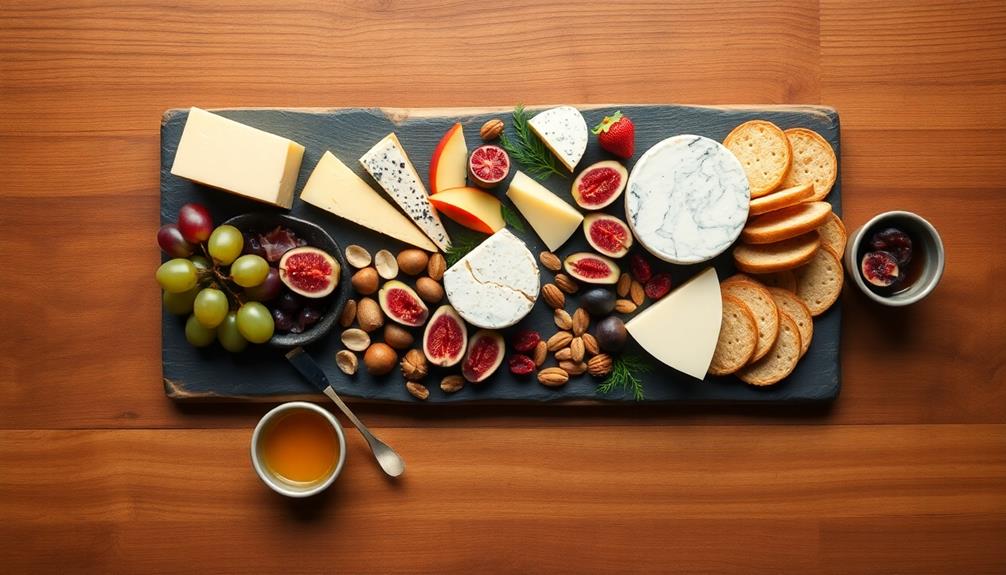
After selecting your cheeses, it's time to arrange the accompaniments and garnishes. Start by choosing a variety of textures and flavors that complement your cheeses. For instance, consider adding seasonal elements like GEEORY Fall Pillow Covers to enhance your cheese plate's presentation.
Add fresh fruits like grapes, sliced apples, or pears for a sweet contrast. Include dried fruits such as apricots or figs for a chewy texture. Don't forget about nuts – walnuts, almonds, or pecans add a nice crunch.
For savory options, add olives, cornichons (small pickles), or roasted peppers. Spread some honey or fig jam on the plate for a touch of sweetness. Place small bowls of these condiments near the cheeses they pair best with. Add some crusty bread or crackers for serving. If you’re looking to add some heartier options to your cheese plate, consider adding some sliced meats like prosciutto, salami, or bresaola. These savory meats make a great addition to any cheese board and can be easily paired with a variety of cheeses. And don’t forget to include some woodfired pizza for a crowd-pleasing option that will definitely satisfy everyone’s cravings.
Now, let's talk about the arrangement. Start with the cheeses as the focal point, spacing them out on your plate or board. Place the accompaniments in small groups around the cheeses, creating an appealing visual balance. Use fresh herbs like rosemary or thyme as garnishes to add color and aroma.
Remember to leave some space between items so guests can easily access everything. Your artisanal cheese plate is now ready to impress!
Step 3. Add Sliced Fresh Fruits
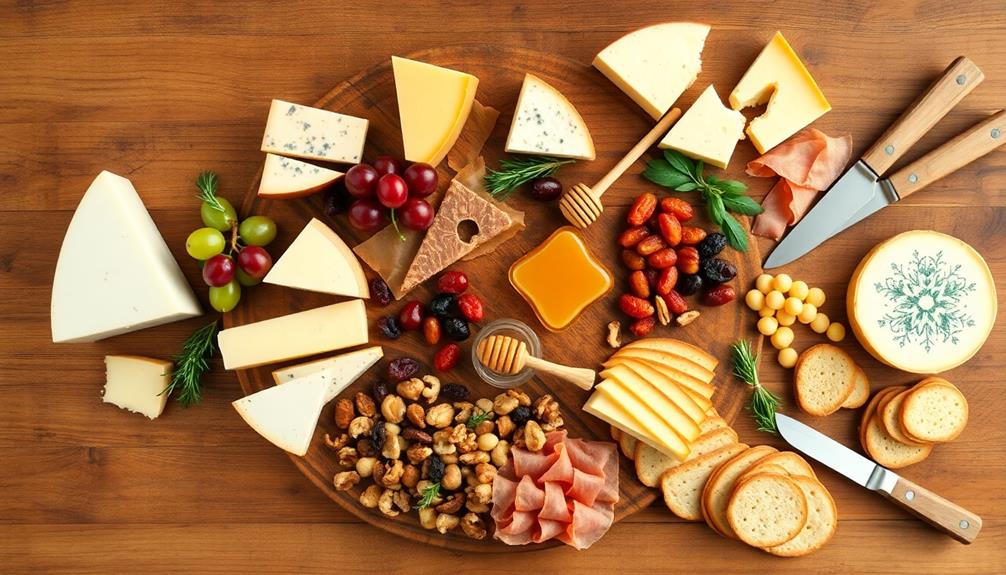
Freshness is key when adding sliced fruits to your artisanal cheese plate. Choose fruits that are in season and at their peak ripeness for the best flavor and appearance, as this will enhance the overall experience.
Start by washing and drying your selected fruits thoroughly. Then, slice them into bite-sized pieces that are easy to eat alongside cheese. You can also consider using organic fruits to ensure quality and safety, aligning with the importance of eco-friendly materials.
Apples and pears are classic choices that pair well with many cheeses. Cut them into thin wedges or slices, removing any seeds or cores. For grapes, you can leave them whole or cut them in half for easier eating. Figs are delicious when quartered, while stone fruits like peaches or plums can be sliced into thin wedges.
Don't forget about berries! Strawberries can be halved or quartered, while blackberries and raspberries can be left whole. If you're using citrus fruits, segment them carefully to remove any bitter pith.
Arrange your sliced fruits on the plate, placing them near cheeses they complement. For example, put apple slices next to sharp cheddar or pear wedges near blue cheese. This thoughtful arrangement will enhance your guests' tasting experience.
Step 4. Include Crusty Bread Slices
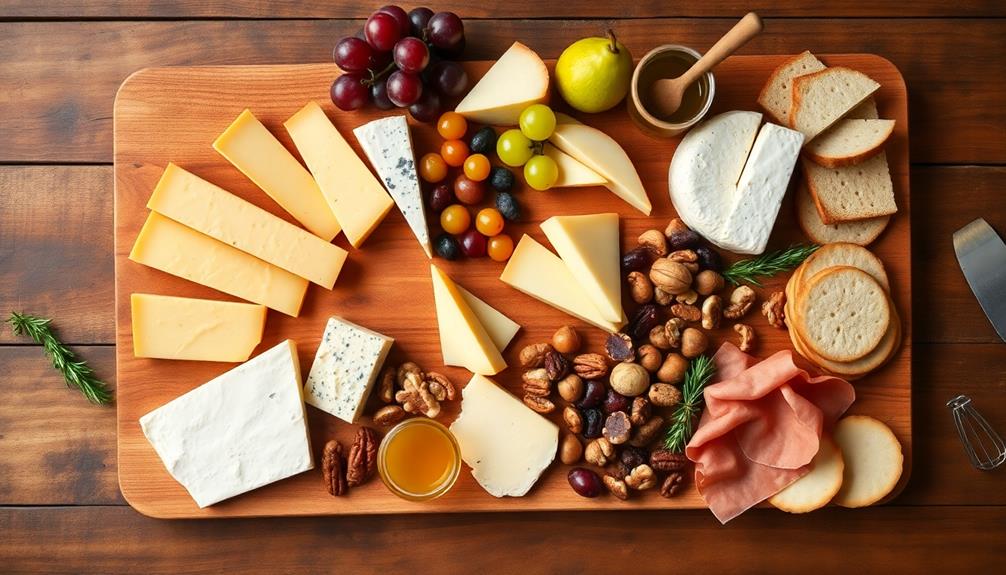
To complement your artisanal cheese plate, you'll need to include some crusty bread slices. Start by choosing a high-quality artisanal bread, like a French baguette or sourdough loaf.
Preheat your oven to 350°F (175°C) to lightly toast the bread.
Slice the bread into thin pieces, about 1/4 inch thick. You don't want the slices too thick, as they might overpower the cheese flavors.
Arrange the slices on a baking sheet in a single layer. Toast them in the oven for about 5-7 minutes, until they're lightly golden and crispy on the edges.
Once toasted, let the bread cool for a few minutes before adding it to your cheese plate. You can arrange the slices in a small basket or fan them out on the plate itself.
If you're feeling fancy, you can lightly brush the toasted bread with olive oil and sprinkle with herbs like rosemary or thyme. This adds an extra layer of flavor that pairs well with many cheeses.
Step 5. Pair With Appropriate Wines
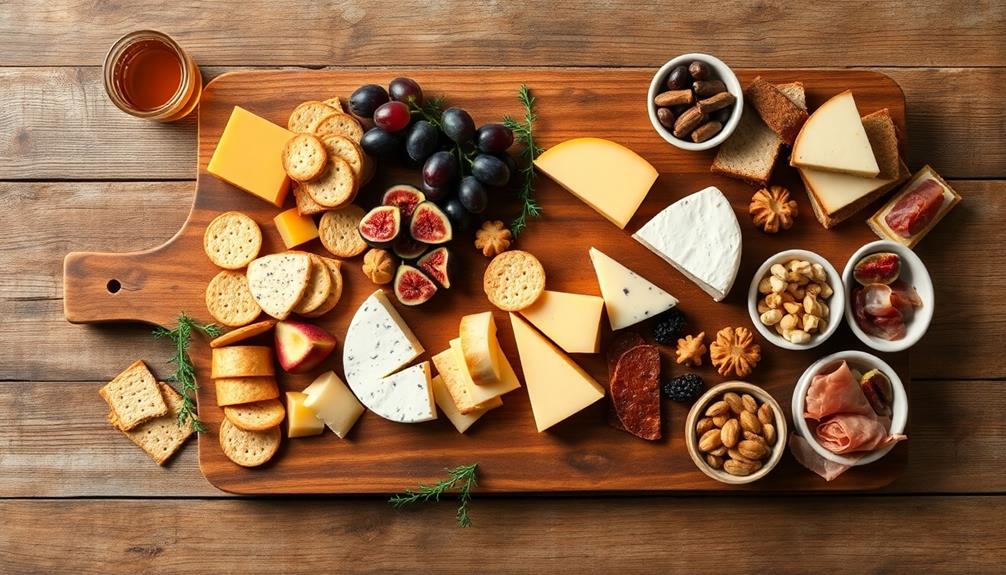
Now that you've assembled your cheese plate and added crusty bread, it's time to consider the perfect wine pairings. Choosing the right wines can enhance the flavors of your cheeses and create a harmonious tasting experience.
For soft, creamy cheeses like Brie or Camembert, try a light, crisp white wine such as Sauvignon Blanc or Pinot Grigio. These wines' acidity cuts through the richness of the cheese. Additionally, pairing your cheese plate with a soothing herbal tea, like chamomile, can promote relaxation during your tasting experience best herbal tea for period pain.
If you've included aged, hard cheeses like Cheddar or Gouda, opt for a full-bodied red wine. Cabernet Sauvignon or Merlot work well, as their tannins complement the cheese's sharpness.
For blue cheeses, sweet dessert wines like Port or Sauternes are excellent choices. The sweetness balances the cheese's salty, pungent flavors.
Don't forget about sparkling wines! They're versatile and pair nicely with a variety of cheeses. A dry Prosecco or Champagne can cleanse your palate between bites.
Final Thoughts
Assembling an artisanal cheese plate is both an art and a delightful culinary experience. As you've learned, there's more to it than just putting cheese on a board.
You've discovered how to choose a variety of cheeses, add complementary accompaniments, and pair them with the right wines. Remember, practice makes perfect, so don't be afraid to experiment with different combinations.
Your cheese plate is a reflection of your taste and creativity. It's a great way to impress guests or simply treat yourself to a special snack.
As you become more comfortable with cheese pairings, you'll find that your plates become more exciting and flavorful. Don't forget to consider the seasons when selecting your cheeses and accompaniments. Lighter options are great for summer, while richer choices work well in colder months.
Lastly, always serve your cheese at room temperature to bring out its full flavor.
With these tips in mind, you're well on your way to creating stunning artisanal cheese plates that will delight your taste buds and those of your guests. Enjoy the journey of cheese exploration!
Frequently Asked Questions
What Wine Pairs Best With an Artisanal Cheese Plate?
You'll find that a versatile wine like Riesling or Pinot Noir pairs well with various cheeses. If you're looking for a red, try a light-bodied Beaujolais. For whites, consider a crisp Sauvignon Blanc or Chardonnay.
How Long Can Cheese Sit Out at Room Temperature?
You shouldn't leave cheese out for more than two hours. It's best to serve it at room temperature, which takes about 30 minutes to an hour. After that, refrigerate it to prevent bacterial growth.
Are There Any Non-Dairy Alternatives for Artisanal Cheese Plates?
You'll find plenty of non-dairy alternatives for cheese plates. Try nut-based cheeses, like cashew or almond varieties. You can also use hummus, olive tapenade, or roasted vegetables. Don't forget about vegan spreads and plant-based dips too.
How Many Types of Cheese Should Be Included on a Plate?
You'll want to include 3-5 different types of cheese on your plate. It's best to offer a variety of textures and flavors, from soft to hard and mild to strong. Don't forget to balance your selections!
What Are the Best Accompaniments for an Artisanal Cheese Plate?
You'll want to include a variety of accompaniments. Try fresh and dried fruits, nuts, honey, jellies, and crusty bread. Don't forget olives, cured meats, and pickled vegetables. These will complement and enhance your cheese selections perfectly.
